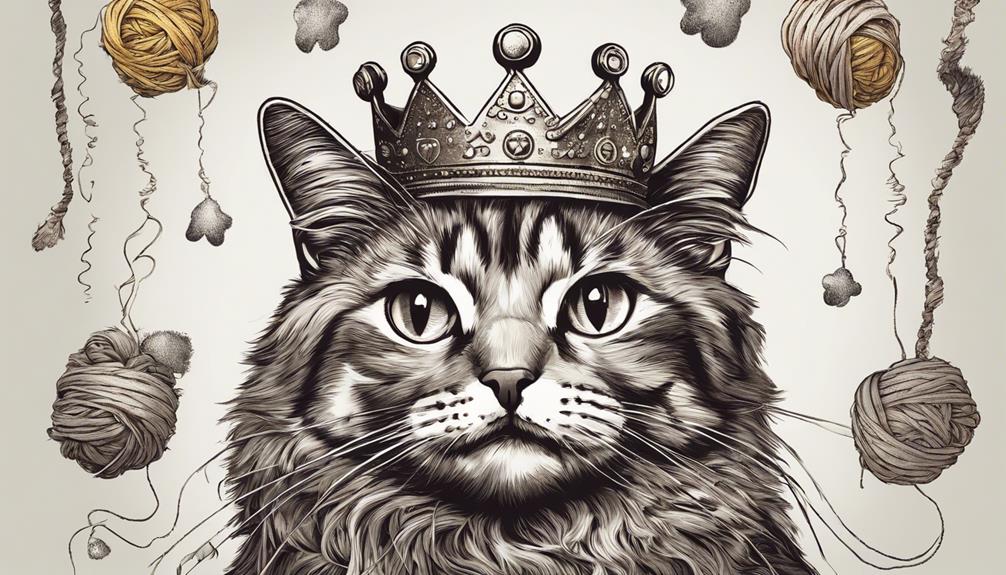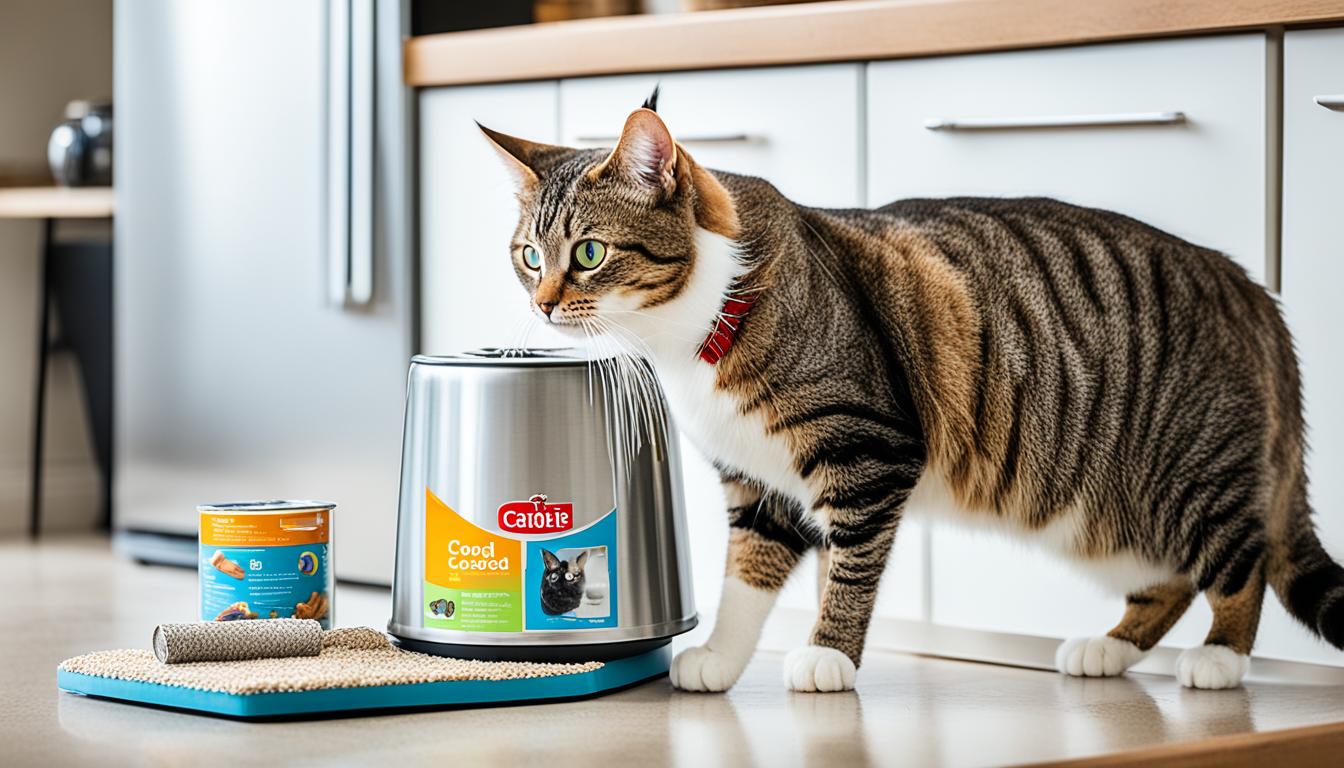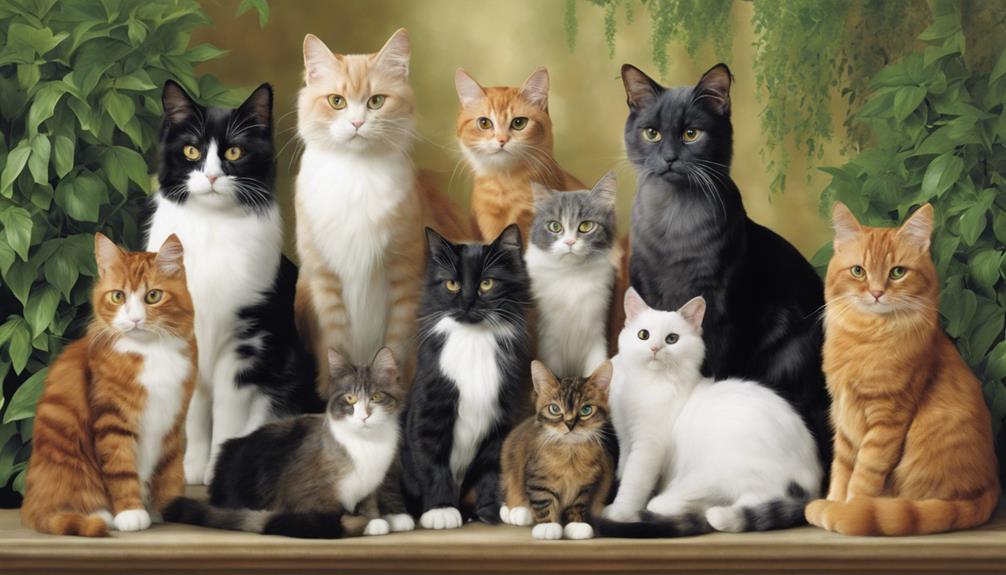Open Farm Raw Mix Cat Food stands out by combining freeze-dried raw protein and bone broth with nutrient-rich superfoods, providing a high-quality and appealing meal option for our feline companions. This blend contains a grain-free mixture of chicken, turkey, and essential bone broth, promoting a range of health benefits such as joint support and healthy skin. Furthermore, the incorporation of superfoods like pumpkin, coconut oil, cranberries, and turmeric highlights benefits including digestive health, skin and coat nourishment, and anti-inflammatory properties.
Made in the USA with locally sourced ingredients and prioritizing animal welfare, this cat food guarantees quality and safety with no recalls on record. The burst of tasty protein, supplemented by freeze-dried raw chunks, adds essential nutrients and flavor to every bite, mimicking the ancestral diet of cats.
Key Takeaways
- Combination of freeze-dried raw protein and bone broth for essential nutrients and enticing texture.
- Grain-free recipe with chicken, turkey, and superfoods for joint, skin, and muscle health.
- Inclusion of superfoods like pumpkin, coconut oil, cranberries, and turmeric for added health benefits.
- Made in the USA with locally sourced ingredients, ensuring quality and safety.
- Utilizes innovative freeze-drying techniques to preserve nutrients, flavors, and meal freshness.
Freeze-Dried Raw Protein and Bone Broth
I absolutely love the way Open Farm RawMix Cat Food combines freeze-dried raw protein and bone broth to create a uniquely nutritious and delicious meal for cats. The freeze-dried raw chunks in the kibble offer a natural and minimally processed protein source that cats adore. Not only does the freeze-dried raw coating add a delightful texture to the kibble, but it also entices even the pickiest eaters to indulge in every bite. The inclusion of bone broth in RawMix is a game-changer, providing essential nutrients like collagen that support joint health, ensuring our feline friends stay active and agile for years to come.
What sets Open Farm RawMix apart is the thoughtful combination of freeze-dried raw protein and bone broth, making it a premium choice for cat nutrition. This unique blend of ingredients not only enhances the flavor but also provides a well-rounded meal that supports overall feline health. Your cat will thank you for choosing such a delectable and beneficial option.
Grain-Free Chicken Cat Food

Combining 100% animal welfare-certified chicken and turkey, Open Farm RawMix offers a grain-free cat food option that prioritizes both taste and well-being for your feline companion. This grain-free chicken cat food is specially crafted to cater to your cat's needs, providing essential nutrients like chicken liver, necks, gizzards, and bone broth. Not only does it support overall well-being, but it also promotes joint health, skin health, and muscle development.
What sets this grain-free chicken cat food apart is its allergy-friendly nature, making it suitable for cats with grain sensitivities. By eliminating grains from the formula, this cat food guarantees that your furry friend can enjoy a delicious meal without any potential allergens.
Inclusion of Superfoods
Superfoods such as pumpkin, coconut oil, cranberries, and turmeric are key components in Open Farm RawMix cat food, providing essential nutrition for feline health. These ingredients offer a variety of benefits for your cat:
- Pumpkin aids in digestion and provides fiber, promoting a healthy gut function.
- Coconut oil contributes healthy fats that support skin and coat health, giving your cat a shiny coat.
- Cranberries contain antioxidants that help maintain urinary tract health, reducing the risk of infections.
- Turmeric possesses anti-inflammatory properties, which can benefit cats with joint issues or inflammation, helping them stay active and agile.
These superfoods aren't only tasty additions to your cat's diet but also packed with vitamins, minerals, and antioxidants that are essential for overall well-being. By incorporating these nutrient-rich ingredients into Open Farm RawMix, your cat can enjoy a balanced and wholesome meal that supports their health from the inside out.
Nutrient-Dense Meal Option

Open Farm RawMix Cat Food provides a nutrient-dense meal option that's rich in essential nutrients for our feline friends.
The balanced meal formulation includes high-quality proteins such as chicken, turkey, and wild-caught fish to support overall health.
With a mix of meat, organs, bones, and natural superfoods like bone broth and coconut oil, this cat food offers a well-rounded and nourishing diet for your pet.
Rich in Essential Nutrients
Rich in essential nutrients, the Raw Mix cat food from Open Farm provides a nutrient-dense meal option for feline companions.
- The recipe includes high-quality ingredients such as chicken, turkey, fish, and organ meats to guarantee a balanced and complete diet for your cat.
- With bone broth, coconut oil, and superfoods, Raw Mix delivers essential nutrients important for overall feline health.
- Omega-3 fatty acids sourced from fish are incorporated into the food, promoting healthy skin, coat, and joint function in cats.
- Your cat can benefit from the protein-packed kibble, freeze-dried raw coating, and natural ingredients present in Open Farm Raw Mix, supporting their overall well-being.
Balanced Meal Formulation
Filled with a mix of premium meats and nourishing components, Open Farm RawMix provides a balanced meal recipe that guarantees high-quality nutrition for your feline friend. This nutrient-dense meal option includes chicken and turkey, along with wholesome bone broth, ensuring a complete and balanced diet for your cat. The grain-free formula caters to felines with sensitivities, offering a biologically appropriate choice. Open Farm RawMix stands out for its sustainable and premium ingredients, reflecting a commitment to quality and health. Your cat will thrive on this carefully crafted blend that prioritizes essential nutrients, protein, and healthy fats. Give your pet the best with RawMix—the ideal choice for those seeking excellent nutrition and overall well-being in their beloved cats.
| Nutrient-Dense Ingredients | Benefits |
|---|---|
| Chicken | Rich in Protein |
| Turkey | Packed with Nutrients |
| Bone Broth | Supports Overall Health |
| Grain-Free Formula | Biologically Appropriate |
Made in the USA

Produced in Minnesota, Open Farm Raw Mix Cat Food is a testament to the brand's commitment to quality sourcing and manufacturing in the USA. Here are four reasons why the USA-made Open Farm Raw Mix Cat Food stands out for pet owners:
- Locally Sourced Ingredients: Open Farm prioritizes ingredients sourced locally, guaranteeing freshness and supporting local farmers.
- Animal Welfare Standards: The brand upholds strict animal welfare standards in its production process, demonstrating a dedication to ethical practices.
- No Known Recalls: With no reported recalls, Open Farm demonstrates its dedication to quality control and safety, offering reassurance to pet owners.
- Transparency and Quality Control: Open Farm's emphasis on transparency and high editorial standards distinguishes it in the pet food industry, providing pet owners with a dependable and reliable choice.
Opting for Open Farm Raw Mix Cat Food not only supports local production but also ensures your feline companion receives a high-quality and safe diet.
High-Quality Ingredients

Utilizing premium, nutrient-dense meats and bone, Open Farm RawMix Cat Food guarantees a balanced and high-quality diet for feline companions. The raw mix cat food features 100% animal welfare-certified chicken and turkey, ensuring that your beloved pet receives ethically sourced ingredients. These nutrient-dense meats, organs, and bone provide essential nutrients for your cat's overall health and well-being. Additionally, the protein-packed kibble is coated in flavorful bone broth, adding a delicious twist to mealtime while offering extra benefits.
For a delightful texture and added nutrition, Open Farm includes freeze-dried raw chunks in their RawMix Cat Food. This innovative addition not only enhances the taste but also provides a boost of essential nutrients. When it comes to sourcing ingredients, Open Farm prioritizes transparency and high-quality standards, guaranteeing a premium product for your furry friend. By choosing Open Farm RawMix Cat Food, you can be confident that your cat is getting a diet that's both nutritious and ethically sourced.
Innovative Preparation Methods

I can't wait to tell you about the innovative preparation methods used in Open Farm Raw Mix Cat Food.
Their freeze-drying technique locks in all the nutrients and flavors of the raw ingredients, ensuring a wholesome meal for your feline friend.
The bone broth coating adds a nutritious and tasty touch that enhances the overall dining experience for your cat.
Fresh Ingredients Selection
With a meticulous approach to ingredient selection and innovative preparation methods, Open Farm RawMix cat food stands out for its dedication to providing fresh and nutritious meals for feline companions.
The company uses human-grade, non-GMO meats such as chicken, turkey, and wild-caught fish to guarantee excellent nutrition. Each ingredient is carefully chosen and prepared using cutting-edge techniques to maintain maximum nutritional value.
The freeze-dried raw coating on the kibble not only preserves flavor but also locks in essential nutrients, creating a delicious and wholesome meal for your cat. Additionally, Open Farm RawMix offers a unique blend of meat, organs, and bones to replicate a cat's natural prey diet, while the inclusion of bone broth supports joint health in cats.
Raw Food Safety
Implementing innovative freeze-drying techniques, Open Farm RawMix guarantees the safety and quality of its raw ingredients while preserving their nutrients and flavors effectively. This freeze-drying process efficiently removes moisture without compromising the food's integrity, ensuring a safe product for your feline friend.
Unlike traditional high-heat processing methods that can diminish essential nutrients in raw food diets, this advanced technique maintains the food's nutritional value. Open Farm's dedication to food safety is evident through rigorous testing and quality control measures at every stage of production.
Burst of Tasty Protein

Indulging your cat with Open Farm Raw Mix Cat Food means providing them with a delectable burst of tasty protein essential for their muscle development and overall health. Here are some key points about the protein content in this nutritious meal:
- Minimum Crude Protein: Open Farm Raw Mix Cat Food contains a minimum of 38% crude protein, ensuring your cat gets the protein they need for peak health.
- Variety of Protein Sources: The protein sources in this food include chicken, turkey, menhaden fish meal, ocean whitefish meal, and herring meal, offering a diverse array of flavors and nutrients for your cat.
- Supports Muscle Development: These protein-rich ingredients support muscle development, helping your cat maintain a healthy and active lifestyle.
- Essential Amino Acids: The high-quality protein content in Raw Mix provides essential amino acids necessary for your cat's overall well-being, ensuring they've the building blocks for a strong and lean body.
Freeze-Dried Raw Chunks

Introducing freeze-dried raw chunks into Open Farm Raw Mix Cat Food enhances both the flavor profile and essential value of the meal for your feline companion. These nutrient-dense chunks are coated with a freeze-dried raw coating that locks in the crucial nutrients and natural flavors of the ingredients. This unique texture not only provides added flavor but also offers a sensory experience that your cat will love.
The freeze-drying process helps retain essential vitamins, minerals, and enzymes present in the raw ingredients, ensuring that your cat receives a wholesome and balanced diet. By incorporating freeze-dried raw chunks into your cat's food, you aren't only giving them a delicious meal but also providing them with a variety that can make mealtime more exciting.
Your cat will enjoy the added crunch and taste that these freeze-dried raw chunks bring to their bowl, making mealtime a delightful experience every time they eat their Open Farm Raw Mix Cat Food.
Unique Flavor Profiles

Crafted with care and attention to detail, Open Farm RawMix cat food boasts a range of unique flavor profiles to tantalize your feline friend's taste buds.
- Open Prairie Grain-Free RawMix combines humanely raised chicken and turkey to create a one-of-a-kind taste experience.
- The Wild Ocean Grain-Free RawMix offers a distinctive blend of wild-caught rockfish, salmon, and whitefish for a unique seafood flavor that cats love.
- Both formulas are enriched with bone broth, providing not only added nutrition but also enhancing the overall taste, setting them apart from traditional cat foods.
- The freeze-dried raw coating on the kibble adds a crunchy texture and intensifies the flavors, making mealtime exciting and satisfying for your cat.
Your cat can now enjoy a blend of 100% animal-based ingredients that cater to their natural cravings, providing a raw blend that mimics their ancestral diet. With Open Farm RawMix, mealtime becomes an adventure for your feline companion, offering a variety of flavors and textures that reflect their unique taste preferences.
Frequently Asked Questions
Is Open Farm a Good Cat Brand?
Open Farm is an exceptional cat brand. Their commitment to transparency, quality ingredients, and animal welfare standards makes them a top choice for me. Their RawMix cat food line's high meat content and unique blend set them apart.
What Are Unique Dietary Requirements for Cats?
As a cat owner, I know cats require a diet rich in animal-based proteins for essential amino acids like taurine. Their carnivorous nature demands a meat-rich diet to support muscle development, skin health, and overall well-being.
What Is the Healthiest Raw Meat for Cats?
For my kitty companion, the healthiest raw meat includes chicken, turkey, and fish. These high-quality proteins pack essential nutrients like amino acids and healthy fats. Choosing humanely raised sources guarantees excellent nutrition, promoting ideal feline health.
Why Do Vets Not Like Grain Free Cat Food?
I'll share why vets may hesitate with grain-free cat food. Some worry about heart health. These diets might lack key nutrients like taurine. The FDA explores links to heart disease. It's wise to check with your vet before switching diets.
What Sets Open Farm Raw Mix Cat Food Apart from Small Batch Raw Cat Food?
Open Farm Raw Mix Cat Food offers a larger variety of ingredients compared to small batch raw cat food, providing a wider range of flavor and nutrient options for your feline friend. Additionally, Open Farm’s commitment to sustainable sourcing and ethical farming practices sets it apart in the pet food industry.
Conclusion
In the vast world of cat food options, Open Farm Raw Mix stands out like a shining star. With its unique features such as freeze-dried raw protein, grain-free formula, and inclusion of superfoods, it offers a nutrient-dense and tasty meal option for your feline friend.
Made in the USA with innovative preparation methods, this cat food provides a burst of protein in unique flavor profiles that will have your cat purring with delight. Experience the difference with Open Farm Raw Mix today!










